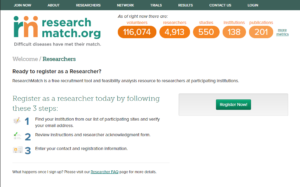Top 10 Social Media Recruitment Rules
So you want to use social media to recruit volunteers for research? While no “formal” rules currently exist, here are some basic considerations to keep in mind. And always remember the most important rule…

#1: Follow IRB guidelines!
DO Be sure that social media is included as part of your IRB-approved recruitment plan BEFORE posting any IRB-approved recruitment ads.
DO NOT post any recruitment ads to social media until AFTER the messages and corresponding images have been approved by the IRB.
Great, now that we have that out of the way, we can move on down the list:
#2: Create your online persona. Think about the target demographic you are recruiting (age, gender, health, emotional/physical conditions, online/offline presence, interests, etc). Create your own template or use a free persona-building tool like Xtensio to help you get started.
#3: Research demographics. Use free resources like Pew Research Center to find out if your persona, or target population, is online. Once you know WHO you are recruiting and WHAT study you are recruiting to, you need to know WHEN and WHERE your population is online, and that will shape HOW you place your recruitment ads.
#4: Seek out training. Use Facebook Blueprint ad training modules, AND attend recruitment webinars to learn the ropes. Don’t go into this endeavor blind, go into it prepared! Know what others are doing, and modify their model to fit your specific recruitment needs and goals.
#5: Budget appropriately. A Facebook campaign can run anywhere from $1,000-$5,000 per recruiting site, depending on your outreach plan. Common conditions and larger recruitment goals will mean more money.
#6: Plan your social media strategy and calendar. Recruitment ads should take interested volunteers directly to a study-specific landing page or website where they can learn about the study and contact the study team for more information. Key questions for the calendar- How often will you post? Where will you post? What times will you post?
 #7: Have support. You want this recruitment campaign to be successful, so plan for it to be. Have adequate staff to support an influx in phone calls or emails, and have screening appointments readily available.
#7: Have support. You want this recruitment campaign to be successful, so plan for it to be. Have adequate staff to support an influx in phone calls or emails, and have screening appointments readily available.
#8: Control comments. Even when people “volunteer” their info online, it’s the research team’s responsibility to monitor the ad and take any questions or comments offline for further discussion. Only post to social media sites that allow you to control comments and delete, hide, or block at your discretion.
#9: Track and measure success. Be sure to analyze the available social media metrics like reach and clicks. Use Google Analytics to capture how many volunteers go to the study-specific website and click your “call to action.” Adjust your plan according to what’s working, what’s not working, and the progress towards meeting your recruitment goal.

#10: Use ResearchMatch.org! Find out if you work with one of the 138 major academic institutions across the United States already using ResearchMatch for recruitment. If you are, then all you need to do is reach out to your institutional liaison who can help you register your study and begin recruiting from the only disease-neutral, institution-neutral, nationwide volunteer registry. If your institution is not yet part of the ResearchMatch network, find out what you need to do to sign up.
Additional FREE recruitment and retention resources:
-
Trial Innovation Network: Recruitment & Retention Toolkit
-
E-Recruiting: Using Digital Platforms, Social Media, and Mobile Technologies to Improve Clinical Trials Enrollment
-
Building a Successful Patient Recruitment Plan & Budget
-
Do Patient Recruitment Advertising & Awareness Campaigns Really Work?
More by the Author
PowerPoint Hacks for Scientific Poster Design
How to Use the Healthcare Hashtag Project to Disseminate Research







0 Comments